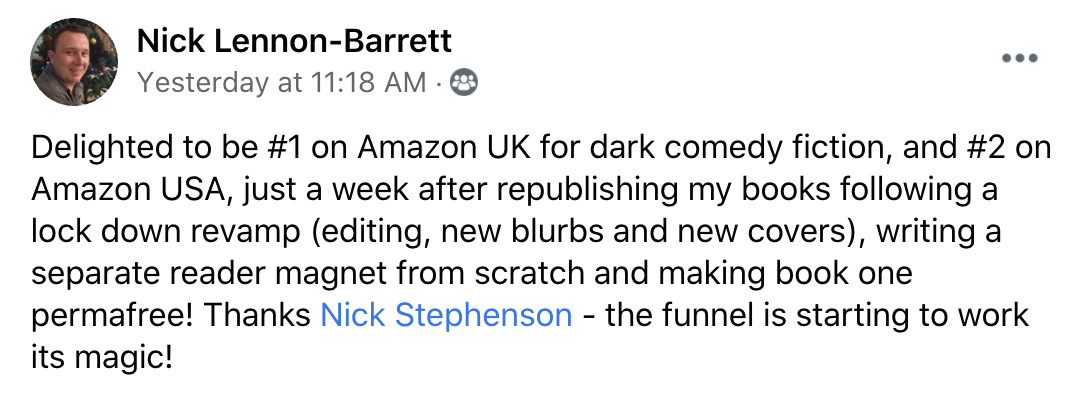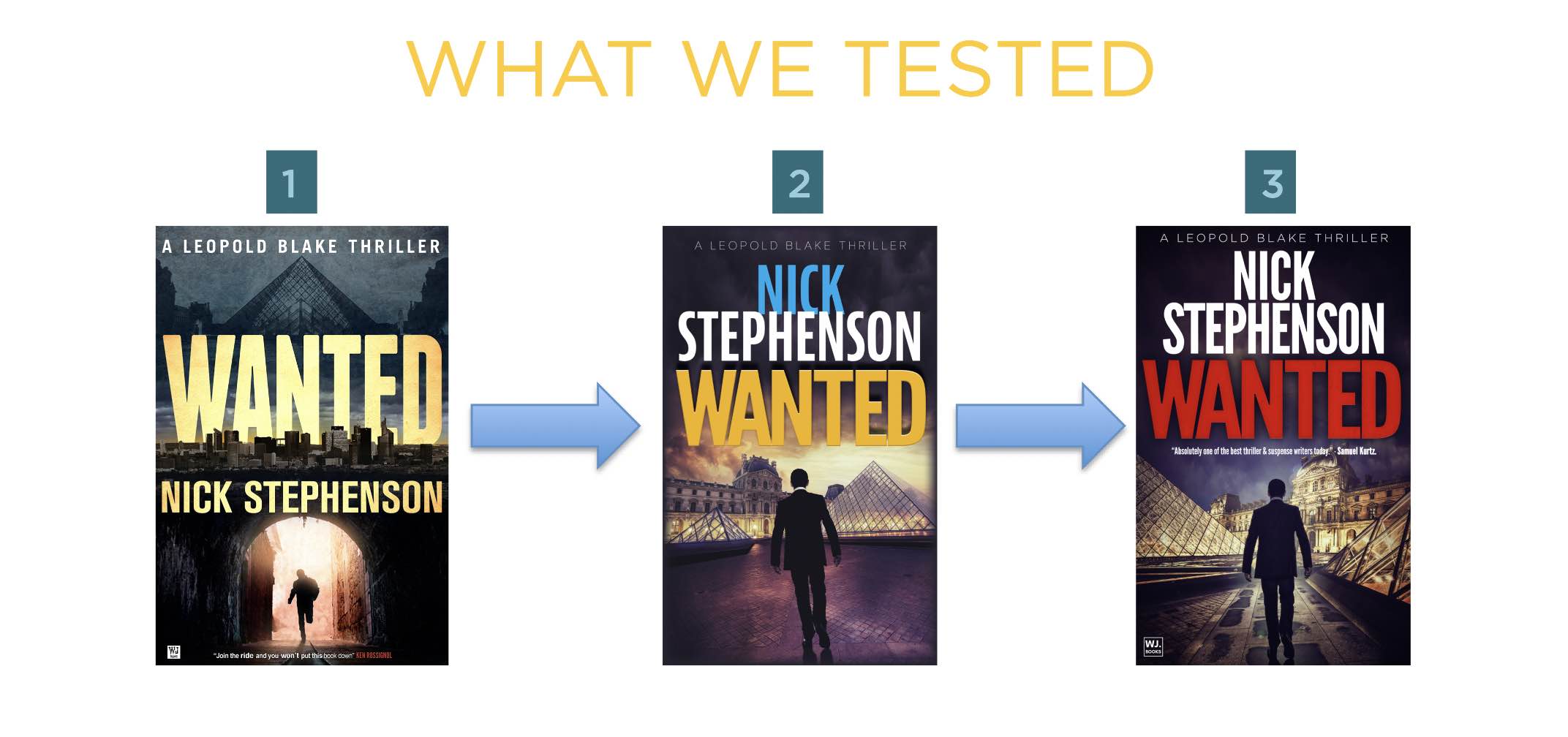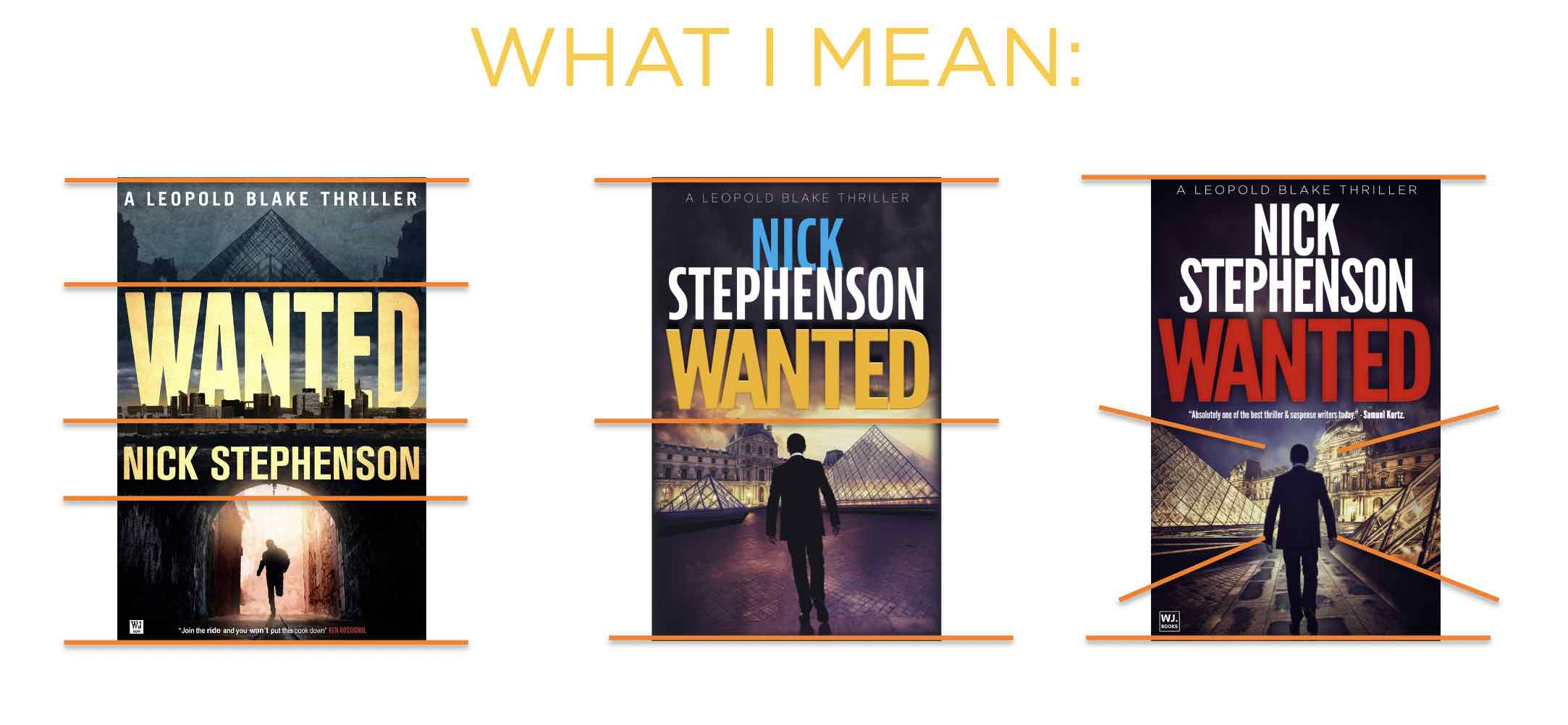^^ Watch the video above for an introduction to this lesson, and what else is coming your way.
Let’s get stuck in…

In the last lesson, we talked about how “knowing your numbers” can be a huge advantage – insofar as if you know how much each click will earn you, you’ll know how many clicks per day you’ll need to hit your revenue goals.
(In the examples I gave, hitting $1k per month from 1 book took 95 clicks, with 6 books it took 44 clicks – neither being particularly insurmountable even for beginners).
So the obvious question is: “how do I get those clicks then, Nick?”
Naturally, we’ll get to that.
But first… we want to make sure those clicks will actually do something useful before we invest time, energy, or money in getting them. After all, there’s no point spending all that effort getting traffic if it’s not performing as well as it could be.
Recently, we experimented with over 20M ad impressions using Amazon Ads and used the data to make some tweaks – and found overall sales tripled. Which is awesome, because you just do the work once – and it’s done.
So that’s what we’re talking about today – how to make those clicks convert up to three times higher and what it takes to get there (along with some examples – many of which can be done DIY).
So, let’s jump in…
![]()
Before we start sending traffic to our books and websites, we need to make sure that traffic is going to “do something useful” once it gets there. After all, there’s no sense spending all that time and effort getting clicks if those clicks don’t convert!
In most cases, we want our traffic to do two things:
Both actions have tons of value for you, and in some cases you can get people to do both. But before we get to that, we need to make sure our “online assets” (books, webpages, etc.) are geared up to convert as many people as possible to do one (or both) of those two things.
The first place to cast your eye will be your book pages on Amazon and the other stores. In this case, we want as many clicks as possible to turn into sales – and getting this right can make a massive difference – and there are two main things to look at…
Starting with your book covers.
 ^^ Nick hit the top of his categories by following some of the strategies we’ll cover in this series
^^ Nick hit the top of his categories by following some of the strategies we’ll cover in this series
Everyone knows (or hopefully knows) that your cover design can make or break your chances – but what makes a good cover? And why is it so important?
In a nutshell, the perfect cover won’t just help you convert more clicks into sales, it’ll help you get more clicks in the first place. Think about all the thumbnail book covers readers see when they’re browsing for something to read – if your cover isn’t quite right, you won’t get as many clicks.
A great cover can be the difference between “losing money” and earning back a triple-digit ROI.
We ran a little experiment to see how this worked in real life – and ran 20 million Amazon Advertising impressions across 3 different covers to see what worked.
You see, it’s not enough to just have a “nice looking cover” – you need a cover that’s genre appropriate, too. Take a look at what happened when we swapped out one book’s cover and measured the results:

Cover 1 was the original cover. Then we tried 2, and finally settled on 3. At first glance, you might not notice all that much of a difference – but the data proved otherwise…

In other words – cover 3 resulted in nearly 4 times as many sales. And the reason? The composition is better – it draws the eye into the centre of the image. And – for thrillers – having red text also appears to have an influence.

Notice how Cover 1 is divided into 3 sections, and Cover 2 is split in half. The third cover does a better job of drawing the eye – which led to a much higher click-through rate (and conversion rate).
Now, your cover requirements will vary by genre but the principles are the same – research what’s working! Here’s a video breakdown of how to get this right:
Interestingly, the improvement in clicks (the “click through rate”) from cover 1 to cover 2 was close to 50%. Even more interesting, the improvement from cover 2 to cover 3 (which only looks to be a slight change) was nearly 50% again!
In other words, we nearly doubled the number of people clicking through to our book page by changing out the cover.
Not half bad! But what made it such a big change? It all comes down to “what readers expect”.
For thrillers, readers expect an image that “sucks you in” – like a tunnel – and you see rather a lot of red text and bold fonts. Simple changes on the surface, but it goes to show that “having a nice image” isn’t as important as “giving readers what they’re used to”.
So, if you’re planning a cover design, make sure you research “what’s working” in your genre (as they’re all different). And don’t try to re-invent the wheel.
A cover that “meets expectations” will outperform “unusual and interesting” all day long. For example, Erotica author Simone Leigh made some simple DIY tweaks to her covers and saw her results more than double:
![]()
From Simone Leigh – a 10k Readers Student
I’m going to show you a ‘Before and After’ on one of my titles: ‘Bought By The Billionaire’ Box Set One.
It’s a compilation of six short stories, written in series. Part One of the compilation, ‘The Master’s Maid’, is the very first story I ever wrote in this genre. I never had it down as high literature. Certainly, it’s far from being the best piece I ever wrote. But it appeals to a certain audience.

The two covers use exactly the same original stock image, but I redesigned the titles using my four-years-improved skills.
And I went on to do exactly the same for all the other books in the series: short stories 1 to 12, plus Box Set Two. Here’s the result from Amazon for the series follow-up, paid, books in the series.

And with more follow-on titles from the magnets, my ratio kept improving. This is where I was on the two months before I upgraded the covers:

Now see what happened after I upgraded the covers…

The free download numbers are much the same – I’ve not changed my marketing and adverts.
But the paid downloads are up by over 130%. That’s the figure for all my titles together, not just the ‘Bought By the Billionaire’ series.
And before you say, “That’s all very well for you. You’ve been at it for ages. You’ve got lots of books’… These are the equivalent figures for just the ‘Bought By the Billionaire’ series – I wrote the whole first two box sets in 2016, within about four months of starting out.

As you can see, the Free to Paid ratio isn’t far off 1:1
If I’d done the covers right in the first place, four years ago, I’d be a lot further ahead in the game now.
![]()
Thanks Simone!
And if you’d like to read the full article about her DIY covers experiment following the advice in this lesson, check it out over at the blog right here.
And, thankfully, it’s fairly straightforward to figure out where you need to be – a quick research of similar titles selling well in your genre will give you an idea of where to start (not all genres are the same, so definitely do a little research).
Your cover is the #1 reason why readers click through to your book – so it’s important to get right.
But what happens once readers DO click through? If getting the right cover can double your clicks, how can we improve the conversion rate once people land on your book page?
At this point, another factor takes over when determining the actual sale – and getting this right can make a huge difference (we doubled sales doing this – for an almost 4x improvement).
And sure: reviews, pricing, the Look Inside, and various other factors play a role – but by far the biggest influencer when it comes to an actual purchase is the book description.
You know, that 3-4 paragraphs that somehow has to sum up an entire book? That we authors obsess over and worry about above all others?
Yes, that one.
Getting this right can double your sales. Meaning, if you can ALSO double your click-through rate with a perfect cover, you’ve just quadrupled your results. Not bad, right? Let’s take a look…

If the cover design gets you the clicks in the first place, it’s the product description that really nails the sale (after all, readers have already seen your cover by this point – they’re now ready to learn more about the book).
The problem? Authors are good at writing stories, novels, and other long-form copy. What we’re not so good at? Condensing all that down into 3 paragraphs.
A problem I see all the time is authors who write a book description by simply listing out “what happens” in a blow-by-blow rundown of the book’s plot. This is great for a Wikipedia entry, but not so great for getting people to buy.
At the end of the day, your book description is sales copy – which requires a slight shift in mindset…
 ^^ Brandon hit the top of his categories with his first book following some of the strategies we cover in this series
^^ Brandon hit the top of his categories with his first book following some of the strategies we cover in this series
So, let’s take a look at some examples…
Set in Middle-earth, the story tells of the Dark Lord Sauron, who seeks the One Ring, which will help him rule the world.
The Ring has found its way to the young hobbit Frodo Baggins. The fate of Middle-earth hangs in the balance as Frodo and eight companions begin their journey to Mount Doom in the land of Mordor, the only place where the Ring can be destroyed.
Summary: This is what most authors do. List out the main plot points. On the plus side, we’ve covered the main protagonist, antagonist, conflict, and stakes. But it’s not very interesting… It’s basically just a premise.
Sauron, the Dark Lord, has gathered to him all the Rings of Power. All he lacks in his plans for dominion is the One Ring – the ring that rules them all – which has fallen into the hands of the hobbit, Bilbo Baggins.
In a sleepy village in the Shire, young Frodo Baggins finds himself faced with an immense task, as his elderly cousin Bilbo entrusts the Ring to his care. Frodo must leave his home and make a perilous journey across Middle-earth to the Cracks of Doom, there to destroy the Ring and foil the Dark Lord in his evil purpose.
Summary: the information we’re presented with is the same (e.g. – we know what the premise of the book is) but the language used gives us a better emotional connection to the characters and events that are about to unfold.

So, what are the essential elements of a good book description?
You’ll need to start with these “mechanical” elements:
This will give you your premise. From which, you can craft something more exciting. For example, let’s take a look at The Lord of the Rings again…
With those 4 things nailed down, you can start elaborating on them to create your description. It’s not an exact science, but there are a few things you can bear in mind:

And again, we tried out a few different book descriptions with our Amazon Advertising experiment – and found that amping up the language (rather than focusing on plot points) helped us double conversions.
Which isn’t half bad…
And the other good news? This stuff is easy to change. If you decide you’d like to try out a cover tweak or a new description, all you need is a few clicks and you’re done!
So with that in mind – and with all your ducks in a row – your books are set up to convert clicks as effectively as possible, and you have a good idea of how many clicks you need to hit your revenue goals (remember that from Lesson One?).
The next question being, “Where do we get those clicks from, Nick?”
We’ll look at that in the next lesson 🙂
In the meantime, here’s today’s summary and action steps:
Before we spend a ton of time, effort and (in some cases) budget on getting clicks, we want to make sure those clicks will convert as effectively as possible.
There are a million things you COULD obsess about, but there are 2 main things to pay attention to if you really want to move the needle.
In fact, optimising these 2 things could double, or even triple your sales. So let’s make sure they’re both up to scratch before we go out and start bringing in the clicks.
Again, this will build on the “Knowing Your Numbers” lesson [click here if you need a recap] and if you have access to that data, you can tell very quickly if there’s a problem.
If both things are low, both things need work. And while “cover design” can be subjective in some regards, the click and sales data is not.
(If you don’t have access to this data, you can run some simple auto-targeted Amazon Ads and find out pretty quickly – we’ll cover that soon).
So the very first thing you should do if you’re trying to grow your sales is check that these 2 aspects of your book are as optimised as possible – otherwise you’ll be missing out on sales.
Don’t have access to this data yet? Just getting started? Don’t worry! It will come in time – and if you bear these 2 factors in mind, you’re already way ahead of the pack.
In the meantime, leave a comment below if you have questions!